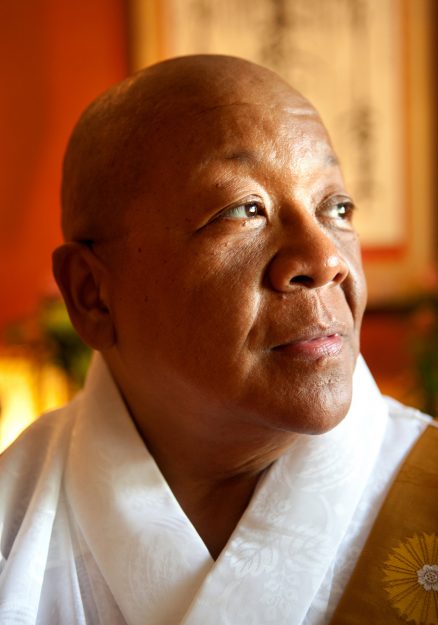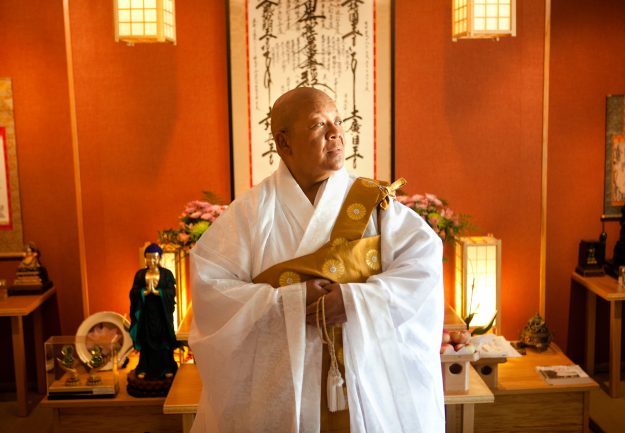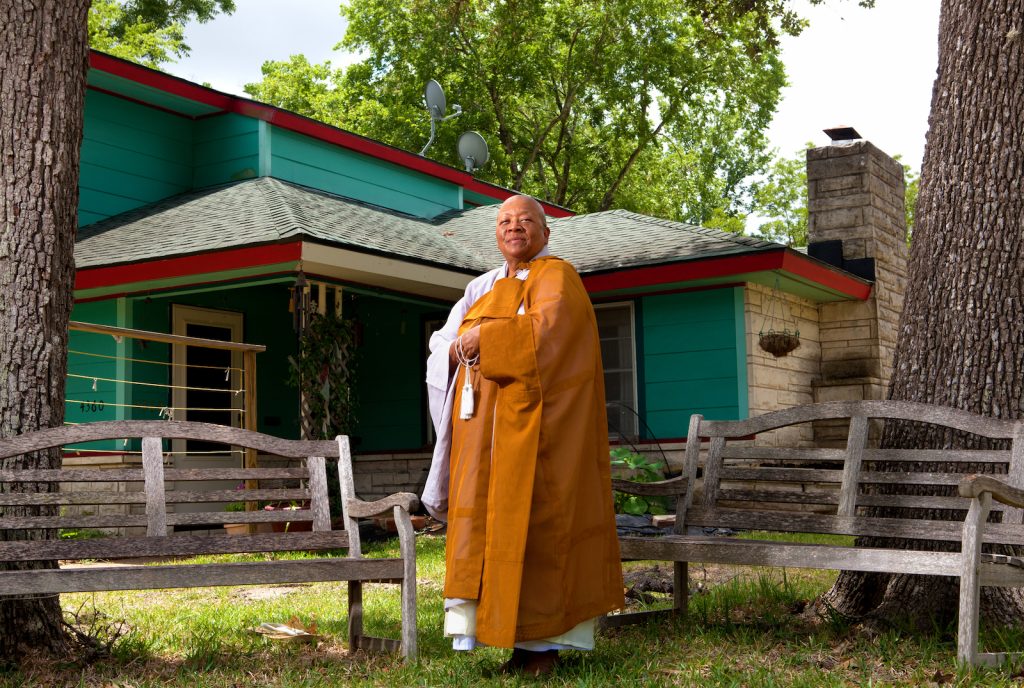Many Westerners who have some familiarity with Nichiren Buddhism conflate the whole of the tradition with Soka Gakkai International (SGI), the most widely practiced Nichiren sect in America. But Nichiren Buddhism is not just SGI. More than two dozen non-SGI sects of Nichiren Buddhism collaborate under an umbrella organization called Nichiren Shu. Curious about these other faces of Nichiren, Linda Heuman spoke with Myokei Caine-Barrett, Shonin, a Nichiren Shu priest and the resident teacher at Myoken-ji, a temple in Houston, Texas.
The daughter of an African American father and a Japanese mother, Myokei Shonin is the first woman of African American and Japanese descent—and the only Western woman—to be ordained as a priest within the worldwide Nichiren Order. (She is also the first female priest in the Nichiren Order of North America.) Speaking candidly of her experience as a woman of color practicing an often-overlooked school of American Buddhism, Myokei guides Tricycle readers into territories that are off the map to many of us.

Tell us about the founder of your tradition, Nichiren Shonin. Nichiren Shonin lived in 13th-century Japan, in what today is known as the Chiba Prefecture. When he was a young man, he made a fervent prayer that he would become the wisest man in Japan—and that’s what he set out to do. He was initially a Tendai monk, and he trained at many temples and monasteries. He felt that the teachings had been corrupted, and he wanted to understand why. He spent years studying the sutras, examining closely the bases for the Tendai claim that the Lotus Sutra was the culmination of all of the teachings of Shakyamuni Buddha and the Buddha’s highest teaching. For example, in the Sutra of Innumerable Meanings, which was preached just before the Lotus Sutra, the Buddha said, “It was with tactful power that I preached the Law variously. In 40 years or more, the truth has not been revealed yet.” On the basis of such statements, Nichiren in the end concurred that the Lotus Sutra was in fact definitive. He believed the corruption of the teachings was due to too much focus on other things besides the Lotus Sutra, such as status and esoteric practices. He wanted to bring Buddhism back to the true intention of the Buddha, and he wanted to make the teachings available for everyone, regardless of their station in life or their education.
Throughout his life he encountered many persecutions, and people tried to stop him. He was thrown into exile. There were attempts to behead him. But he took it all as impetus for promoting the Lotus Sutra.
Chanting, in veneration, the title of the Lotus Sutra “Namu-Myoho-Renge-Kyo” [the Odaimoku, known in some schools as the Daimoku] is our primary practice. Nichiren Shonin understood that for people who were illiterate and impoverished, this was an easy way to open the door. We do also read and chant the Lotus Sutra itself—especially chapters 2 and 16.
Related: Understanding Nichiren Buddhism
How does chanting the Odaimoku lead to enlightenment? Nichiren Shonin said that when you know the name of a person, what comes to you is everything you know about that person—his essence and his being. In the same way, when you chant the title, you are in effect chanting the entire Lotus Sutra. It is the correct name for the reality of all things, the correct rhythm; that reality is already within you as it is everywhere. As you chant the Odaimoku, you fall right into that rhythm. The chanting activates your buddhanature, then your life becomes in tune with the reality of all things.
You live the Lotus Sutra. It’s a discipline: what you think, what you do, what you say. Your thoughts, your words, and your deeds all create karma. And so through practice, you learn how to create better karma, and then everything about your life changes. We suggest if people want to try it, they should just see what happens.
According to the Lotus Sutra, there are five ways of practice: to keep, read, recite, copy, and expound theLotus Sutra. So chanting is simply one form of expressing our faith.
In Nichiren Shu, what is the meaning of faith? What do you have faith in? That something will touch your life, or your heart, or your spirit. What you are hoping for is the confidence to know that you are moving through daily existence doing the absolute best you can in accord with the reality of all things. There are people in some Nichiren schools who believe that you can chant for whatever you want, and chanting is supposed to bring that to you. That’s not our way of thinking at all. We view chanting as a means to center one’s life in the dharma, becoming one with the dharma.
What kind of effect does chanting have on your mind? We consider chanting to be a form of meditation. When you set your intention on chanting correctly, melodically, and as crisply and clearly as possible, you become focused. It quiets the monkey mind and establishes a direct connection to the dharma. I can only guess how it compares to what people experience in silent meditation. The times I have tried silent meditation, it’s been very easy to just pop into this place that I have found through chanting. So I assume it’s the same.
You live the Lotus Sutra. It’s a discipline: what you think, what you do, what you say. Your thoughts, your words, and your deeds all create karma. And so through practice, you learn how to create better karma, and then everything about your life changes.I know when I first heard the chanting, there was something very powerful about it that really appealed to me. It stuck in my head and in my heart. It wasn’t until I started on the path of the priesthood that I finally became aware of why that was so. I was born in Japan and stayed there until I was almost two years old. I must have heard the chant when I was a baby. In the same way, there was a particular smell of incense that just moved me profoundly, and I never knew why. About three years ago, when I was talking to my Japanese aunt, I learned that my family members were actually Nichiren Shu practitioners. We had never discussed it before, and that realization was like coming home.
How did you meet the dharma? I met SGI in the early sixties, when it was known as Nichiren Shoshu of America. I was about 13. Today people of mixed ethnicity are among the fastest-growing populations in the country, but looking back, it was not very comfortable—think of people telling Tiger Woods he had to claim one side or the other; there was a lot of that. I know my mother suffered a great deal because people told her to go back home. She had to deal almost as a single parent, because my father was on active duty in the military and was in and out of the country. It was not an easy life.
My mom’s friend happened to be a Buddhist and invited her to a SGI meeting. She didn’t want to go. But she told me I could go. And then she told me not to join anything; so I had to join, just because she said not to!
I received the Omandala Gohonzon [a devotional scroll], and I kept it with me until I went away to college. It was something that was mine alone. I think that desire for a thing of my own was part and parcel of growing up as a mixed ethnic child and trying to find a place to fit, a place of belonging—and not finding it. Buddhism, especially Nichiren’s teachings, eventually really helped me find myself, not as the person who was African American or Japanese, but just as me—and to be OK as me. I came to understand I was not either/or, but both; and that in itself was unique. But it took me a long time to get there. I was in the Navy Reserves. I was a professional belly dancer for a while. I did a whole bunch of different stuff, and none of it satisfied me for any length of time.
I was involved in SGI for about 35 years—20 years of that was very heavy and active involvement. I was at a point of taking care of people and teaching others when I experienced a great deal of dissatisfaction with the path I was on. I just couldn’t continue, and ultimately I left. I didn’t know what I was going to do or where else to go. It was really traumatic. I was almost 50 years old, and I had been involved with SGI since I was 13.

So what led you to Nichiren Shu? I met two people from the Nichiren Order of North America. I had an instant and strong connection with one of them—Ryuoh Faulconer, Shonin—that developed over months. He eventually became my teacher. Ryuoh, Shonin, mentioned that there were women priests in Nichiren Shu. When he told me this, I regained a dream I had had as a young girl. As a child, I was in love with the Audrey Hepburn movie The Nun’s Story. I wanted to live like that. I was going to serve Jesus (well, the Jeffrey Hunter Jesus in King of Kings) and be a nun. But then I became a Buddhist, and especially in that tradition it was not possible.
I’d always taken care of people, and the idea of service came from my dad. Our house was always open; we had people coming in and out who had nowhere else to go. I grew up in the culture of the military, where if you see a soldier walking, you pick him up and take him where he needs to go. So becoming a priest was just the next step. I took my first vows in 2002. I had to work up to shaving my head, because I had hair down almost to my knees. It took me about two years!
Related: The Great Divide
What’s your sangha in Houston like? They’re all convert Buddhists. We have a significant gay population as well as African Americans, Latinos, and whites. We have about 16 families who are local, and more than 30 who are remote. Of those, 22 sangha members are behind bars, and the rest are scattered from Mexico and Puerto Rico to Florida, Ohio, Tennessee, Oklahoma, and New Mexico. We maintain contact through the Internet or by phone. Some have contacted me from as far away as South Africa and Liberia and asked if I’d be interested in becoming their teacher. Our lineage is one of the few that streams our services.
How did your students who are prisoners find you? We were invited by a group of prisoners to come into the prison. Since they were Nichiren Buddhists, we agreed. But actually some of them were white supremacists! I didn’t find out until last year, when one of the original members got out of prison and he told me the story of how the group got started. It turns out that in order for the prison to allow them to invite us to come in, the group had to be a certain size. The group of Buddhists was actually very small, so they packed their numbers with non-Buddhists who happened to be white supremacists. We [three women of color] all noticed that something was a little odd, because when we’d come in, the African American prisoners would look at us like, “What are they doing here with these white guys?” Everyone kind of waited around to see what we would do and how we would treat them. Once they decided we were OK, they decided to test Buddhist practice out. Some of them actually took up Buddhism and stayed with us for about three or four years. Of those men who have been released from prison, as far as we know only one has reoffended.
You have such a diverse sangha. Is there something in the Nichiren tradition that makes it especially drawing of diversity? We freely share the dharma with anyone who seeks it. When we do a retreat, we charge to cover expenses; otherwise, we leave it strictly up to donation.
There is something here for everyone regardless of their level of income, education, or ability. Chanting the Odaimoku is easily accessible; you don’t have to learn a lot initially. It’s both a gateway and a primary practice. You could continue for years just chanting the Odaimoku.
We all love making noise with our drums. Some people are attracted to the drumming, because it is so primal. On the other hand, some people have a hard time with our drumming. Other Buddhists occasionally look at us like we are supposed to be silent. I hear “Well, the Buddha didn’t do it that way.” And I know the Buddha didn’t do it that way. But there are other ways.
Do you have any advice for how sanghas that are predominantly white can become more inclusive? I think outreach has to happen. Centers that are predominantly white need to become more educated about the challenges facing people of color. As a person of color, I’ve always faced people telling me that race is not an issue or that I’m overreacting. It would help a great deal for sanghas to become educated about unaware racism, institutionalized racism, and internalized racism, so that they don’t negate any person’s experience just because it is not common to the entire community.
I’ve grown up in a tradition that was always very diverse; even so, all of the leadership was either Japanese or white. Any community that wants to welcome diversity has to make sure diversity goes throughout the entire community—including having teachers and administrators of color. It has to look like there’s no difference; and the reality has to be that there is no difference.
As Buddhists, we have an idea of equality: we talk about enlightenment for all beings; we’re all potential Buddhas. In my years of practicing, I have worked with people who are schizophrenic, autistic, transgendered, behind bars—the whole range. If I truly believe that Buddhism is for everyone, then I have to act that way. It requires introspection and a commitment to weeding out everything within that prevents that compassion and acceptance from happening.
I also think that communities of color and women have to stake our claim to whatever it is that we want and honor our right to it. Most of us don’t do that. We are really hesitant. If a place is not welcoming to us right away, then we think, “I don’t need to go there.” But the truth is, if we want the dharma we’ve got to go after it, and we can’t allow anyone else to keep us from it. So if I walk in and people look at me funny, I don’t have to take that on. The dharma is truly for everyone. We must simply engage it with all we are worth.
♦
This article is part of an online special section about Nichiren Buddhism. We hope that by gathering these articles in one place and making them freely available, our Buddhist conversation will be broadened and that we can, all of us, more fully know ourselves in knowing one another. Read the other articles here.
Thank you for subscribing to Tricycle! As a nonprofit, we depend on readers like you to keep Buddhist teachings and practices widely available.
